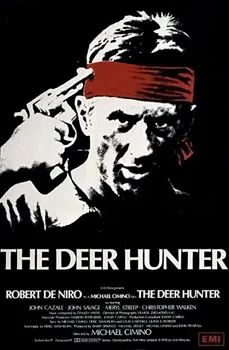Historical accuracy of The Deer Hunter

Historical accuracy of The Deer Hunter

Characters
Michael Vronsky
Michael is a fictional character representing the capable working-class American soldier deeply affected psychologically by the war, embodying themes of survival, loyalty, and trauma.
Nikanor "Nick" Chevotarevich
Nick is a fictional character whose descent into psychological destruction, particularly through the Russian Roulette scenes, symbolizes the devastating and irretrievable losses caused by the war for some individuals.
Steven Pushkov
Steven is a fictional character representing the physical cost of the war, showing the profound impact of severe disability on veterans and their families upon returning home.
Stanley ("Stosh")
Stanley is a fictional character, part of the core group, perhaps representing those who return from war but process or display their experiences differently, or a continuation of pre-war attitudes.
John Welsh
John is a fictional character representing the community element back home, the friend who remains relatively unchanged and provides a familiar anchor point.
Axel
Axel is a fictional member of the close-knit group of friends from the steel town.
More characters
Linda
Linda is a fictional character representing the women impacted by the war, caught between relationships altered by deployment, trauma, and loss.
Angela
Angela is a fictional character representing the spouses dealing with the devastating consequences of war injuries on their partners and their married lives.
Viet Cong Captors
While the Viet Cong were a historical force, the depiction of them systematically forcing prisoners to play Russian Roulette is not supported by historical evidence and is widely considered inaccurate and inflammatory.
Julien Grinda
A fictional character representing the decadent or corrupt foreign presence in wartime Saigon profiting from activities like the Russian Roulette dens depicted.
Story
Depiction of Pennsylvania steel town life/community
The film is praised for its authentic portrayal of the atmosphere, rituals (wedding, hunting), and tight-knit community bonds within a specific American working-class, immigrant-descendant environment (Clairton, PA).
Experience of US soldiers in Vietnam combat
The film captures the chaos, fear, and sudden brutality of jungle warfare effectively, though it focuses more on the psychological impact than specific tactical accuracy.
Capture by Viet Cong
American soldiers were captured by the Viet Cong, so capture itself is historically plausible within the war context.
Forced Russian Roulette by Viet Cong captors
This is the film's most controversial element. There is no historical evidence that the Viet Cong regularly or systematically used Russian Roulette as a method of torture or execution against American POWs.
Escape from captivity
While POW escapes occurred, the specific dramatic escape sequence involving turning the Russian Roulette game on the captors is fictional.
Steven's severe physical injuries
Severe, life-altering injuries like the loss of limbs were a tragic reality for many soldiers in Vietnam due to mines, gunfire, etc.
Difficulty readjusting for returning veterans (Michael)
Michael's alienation, emotional numbness, and difficulty reconnecting with his former life accurately reflects the challenges and PTSD symptoms faced by many returning Vietnam veterans.
Nick's trauma manifesting in Saigon Russian Roulette dens
Nick's fate is tied to the fictional Russian Roulette motif. However, his psychological destruction represents the severe trauma some soldiers experienced, even if the specific manifestation is inaccurate.
The Fall of Saigon (1975) depiction
The film effectively captures the chaos, desperation, and danger during the final days of Saigon, including scenes evoking the US Embassy evacuation.
Michael returning to Saigon to rescue Nick
This plot point, including Michael navigating the fall of Saigon to find Nick in a Russian Roulette den, is entirely fictional.
Nick's death playing Russian Roulette
Tied to the fictional premise, Nick's death serves as the tragic culmination of his trauma within the film's narrative but has no basis in historical fact regarding common war experiences.
Friends singing "God Bless America" after funeral
This final scene is ambiguous but powerfully depicts the characters' grief, fragile community, and complex relationship with patriotism after their experiences. It reflects an emotional truth for many.
Overall portrayal of psychological impact (PTSD)
Despite factual inaccuracies elsewhere, the film is widely recognized for its powerful and groundbreaking portrayal of the deep psychological scars left by the Vietnam War on soldiers.
Setting
Pennsylvania Steel Town (Clairton / Mingo Junction, OH)
Though filmed partly in Ohio and elsewhere, the movie convincingly portrays the gritty, industrial atmosphere, homes, and social hubs (bar, church) of a mid-20th century American steel town.
Russian Orthodox Wedding scenes
The extended wedding sequence captures cultural details and traditions specific to the characters' Russian-American heritage and community.
Appalachian Mountains / Hunting setting
Scenes depicting the mountainous Pennsylvania landscape and the ritual of deer hunting are visually authentic and thematically important.
Vietnam Combat Zones (Jungle, River)
Filmed in Thailand, the locations effectively simulate the challenging jungle and riverine environments where American soldiers fought in Vietnam.
Viet Cong jungle prison camp
The specific depiction (submerged cages, Russian Roulette hut) is tied to fictional events, but visually evokes a primitive, brutal captivity setting.
Saigon streets, bars, gambling dens (pre-fall)
The film captures the vibrant, chaotic, and sometimes sordid atmosphere of wartime Saigon, including the contrast between local life and the presence of foreigners/military personnel.
Fall of Saigon atmosphere (Embassy evacuation implied)
Recreates the panic, crowds, and sense of collapse during the final days of South Vietnam in April 1975, particularly the desperate evacuation scenes.
Period details (late 1960s - mid 1970s America/Vietnam)
Costumes, vehicles, music, and general A/V aesthetics accurately reflect the different time periods and locations depicted in the film.
Steel mill environment
Scenes inside the steel mill effectively convey the heat, noise, danger, and industrial nature of the work dominating the characters' lives back home.
